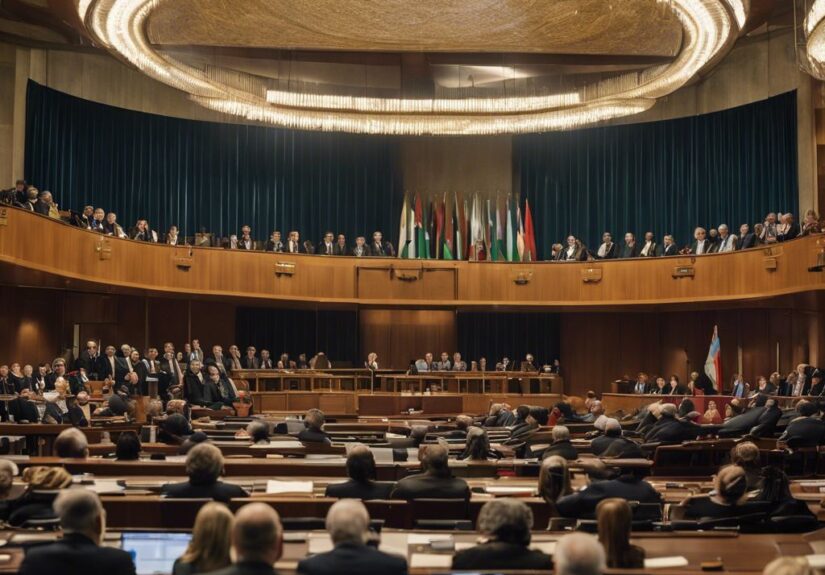International Law and Conflicts: Navigating a Complex Global Landscape

In an era of increasing globalization and geopolitical tensions, international law serves as both a guide and a battleground for resolving conflicts between nations. From territorial disputes to human rights violations, international law provides a framework for diplomatic engagement, legal accountability, and conflict resolution. However, its effectiveness is often challenged by political interests, state sovereignty, and enforcement limitations.

Understanding International Law
International law consists of rules and principles that govern relations between states and other international actors. It is derived from treaties, customary practices, and legal precedents established by international courts and organizations such as the United Nations (UN) and the International Court of Justice (ICJ). These laws aim to promote peace, security, and cooperation on a global scale.
Sources of International Law
International law derives its authority from several key sources, including:
- Treaties and Conventions: Formal agreements between states that outline legal obligations. Examples include the UN Charter, the Geneva Conventions, and the Paris Agreement on climate change.
- Customary International Law: Long-standing practices followed by states out of a sense of legal obligation, such as diplomatic immunity and the prohibition of genocide.
- General Principles of Law: Fundamental legal principles recognized by all nations, such as fairness, good faith, and due process.
- Judicial Decisions and Legal Scholarship: Rulings from international courts and scholarly interpretations that help clarify legal principles and precedents.
Key Institutions of International Law
Several organizations and tribunals oversee the implementation and interpretation of international law:
- United Nations (UN): The primary international body responsible for maintaining global peace and security, with agencies such as the UN Security Council and International Law Commission.
- International Court of Justice (ICJ): The principal judicial organ of the UN, responsible for resolving disputes between states and providing legal opinions.
- International Criminal Court (ICC): A tribunal that prosecutes individuals for war crimes, genocide, and crimes against humanity.
- World Trade Organization (WTO): Oversees trade agreements and dispute resolution among member states.
- Regional Organizations: Entities like the European Court of Human Rights (ECHR) and the African Union’s judicial bodies contribute to the enforcement of international law at regional levels.
Functions and Scope of International Law
International law serves multiple purposes, including:
- Maintaining Peace and Security: Through diplomatic resolutions, peacekeeping missions, and legal deterrents against aggression.
- Facilitating International Trade and Commerce: Establishing regulations to promote fair trade practices and resolve disputes.
- Protecting Human Rights: Enforcing laws against discrimination, war crimes, and other human rights violations.
- Regulating Environmental Protection: Addressing transboundary environmental issues such as climate change, deforestation, and marine pollution.
Despite its wide scope, international law faces challenges in enforcement due to the absence of a central governing authority. Compliance often depends on diplomatic negotiations, economic incentives, and collective international pressure.
The key branches of international law include:
- Public International Law: Governs the relationships between sovereign states and international entities.
- Private International Law: Deals with cross-border disputes between private individuals and corporations.
- Humanitarian Law: Regulates conduct during armed conflicts, including the protection of civilians and prisoners of war.
- Environmental Law: Addresses global environmental issues, such as climate change and biodiversity conservation.
Public International Law: A Closer Look
Public international law plays a vital role in shaping international relations by establishing legal frameworks that guide state conduct. It encompasses various subfields, including:
- Treaty Law: Treaties are formal agreements between states that outline specific rights and obligations. The Vienna Convention on the Law of Treaties (1969) sets the foundational rules for treaty interpretation and enforcement.
- Customary International Law: Based on longstanding practices accepted as legally binding, customary international law fills gaps where formal treaties do not exist. Examples include the prohibition of genocide and the recognition of diplomatic immunity.
- State Sovereignty and Recognition: Public international law defines the legal status of states, including the principles of sovereignty, territorial integrity, and non-intervention. Recognition of new states and governments is a crucial aspect, often influenced by political and diplomatic considerations.
- Law of the Sea: The United Nations Convention on the Law of the Sea (UNCLOS) regulates maritime activities, including territorial waters, exclusive economic zones (EEZs), and deep-sea resource exploitation.
- Human Rights Law: International human rights laws, such as the Universal Declaration of Human Rights (UDHR), set global standards for individual rights and freedoms, enforced through bodies like the International Criminal Court (ICC) and regional human rights courts.
- International Humanitarian Law: Also known as the laws of war, this body of law regulates the conduct of armed conflicts, protecting non-combatants and limiting the means and methods of warfare.
Private International Law: Navigating Cross-Border Disputes
Private International Law, often referred to as conflict of laws, governs the resolution of disputes that involve private individuals or entities from different countries. Unlike public international law, which regulates relations between states, private international law deals with issues such as contractual agreements, family law matters, and property disputes that span multiple jurisdictions. This branch of law seeks to determine which legal system and which jurisdiction should apply in cases involving foreign elements, such as a contract signed in one country but executed in another, or a divorce involving spouses from different nations.
One of the primary challenges of private international law is dealing with the complexity of different legal systems and their conflicting rules. For instance, a company based in the United States entering into a business agreement with a partner in Japan may face complications regarding which country’s laws will govern the contract in the event of a dispute. Moreover, issues like jurisdiction (which court has the authority to hear a case) and the recognition and enforcement of foreign judgments are critical aspects that private international law addresses. To facilitate smoother cross-border interactions, many countries have signed conventions, such as the Hague Conventions, which standardize rules and principles, offering a framework for resolving international disputes more efficiently.
Humanitarian International Law (IHL)
It is a set of rules designed to limit the effects of armed conflict for humanitarian reasons. It seeks to protect individuals who are not taking part in hostilities, such as civilians, medical personnel, and prisoners of war, while ensuring that the means and methods of warfare do not cause unnecessary suffering. The primary source of IHL is the Geneva Conventions of 1949, which, together with their Additional Protocols, lay down the parties’ obligations to a conflict. These rules are intended to protect human dignity during wartime and apply in both international and non-international conflicts.
One of the key principles of IHL is distinction, which mandates that combatants must distinguish between military targets and civilian objects to avoid harming non-combatants. Another principle is proportionality, which ensures that the harm caused to civilians or civilian property during an attack does not exceed the anticipated military advantage. Violations of IHL are considered war crimes and may be prosecuted by international courts such as the International Criminal Court (ICC). Despite its strong moral and legal framework, IHL faces significant challenges in enforcement, particularly in conflicts involving non-state actors or where political considerations hinder accountability.
Environmental International Law
Environmental international law is a branch of international law that addresses the protection and preservation of the global environment through legal agreements, treaties, and conventions. With the growing recognition of environmental challenges such as climate change, biodiversity loss, and pollution, nations have increasingly come together to create frameworks for global cooperation. Key international agreements, like the Paris Agreement on climate change and the Convention on Biological Diversity, reflect the collective commitment of states to mitigate environmental harm and promote sustainable development. These legal instruments aim to regulate the use of natural resources, reduce emissions, and protect ecosystems that transcend national borders, acknowledging the interconnectedness of the planet.
One of the fundamental principles of environmental international law is the idea of “common but differentiated responsibilities,” which recognizes that while all countries share responsibility for environmental protection, the extent of their obligations may differ depending on their economic capacity and historical contributions to environmental degradation. Despite these efforts, the enforcement of environmental laws remains a significant challenge, as there are often limited mechanisms for holding violators accountable, and political and economic interests can undermine global agreements. As environmental issues continue to rise in importance, the evolution of international law will need to address the complex intersection of legal, scientific, and political factors in creating a sustainable future.
The Role of International Law in Armed Conflicts
International law’s involvement in conflicts primarily revolves around ensuring that even during warfare, certain principles of humanity are maintained. The Geneva Conventions, established in 1949, form the cornerstone of international humanitarian law (IHL), which sets out protections for individuals who are not directly involved in hostilities, such as civilians and prisoners of war. Despite these legal frameworks, the enforcement of such laws remains inconsistent, with countries often choosing to ignore or bypass international standards when their national interests are at stake.
Take, for example, the Syrian Civil War. Despite the clear violations of international law—such as chemical weapons attacks against civilians—efforts to hold perpetrators accountable have been slow and ineffective. The challenges are multifaceted: a lack of political will, the veto power of permanent Security Council members in the United Nations, and the presence of non-state actors, such as rebel groups and terrorist organizations, who are not always bound by international treaties.
The Role of International Courts and Tribunals
To ensure accountability in conflict, international courts such as the International Criminal Court (ICC) and the International Court of Justice (ICJ) play vital roles. The ICC is tasked with prosecuting individuals for war crimes, genocide, and crimes against humanity, while the ICJ resolves legal disputes between states. Both institutions are crucial for upholding the rule of law, but they face significant obstacles.
The ICC, for instance, has faced criticism for its perceived bias, with some African nations accusing it of disproportionately targeting leaders from the continent. In contrast, powerful states like the United States, China, and Russia are not signatories to the Rome Statute, which established the ICC, undermining its universality. Additionally, the lack of a global police force means that even if a war criminal is indicted, their arrest is often contingent upon cooperation from other states.
Sovereignty vs. International Intervention
One of the fundamental tensions in international law is the delicate balance between respecting state sovereignty and intervening to prevent human rights abuses. The “Responsibility to Protect” (R2P) doctrine emerged as a response to genocides and mass atrocities, emphasizing that when a state fails to protect its citizens, the international community has a duty to step in. This principle has been invoked in some controversial instances, such as NATO’s 2011 intervention in Libya, which led to the overthrow of Colonel Muammar Gaddafi.
While R2P aims to prevent atrocities, its implementation raises critical questions about the legitimacy of intervention. In some cases, the intervention has been criticized for exacerbating the conflict or for being driven by political interests rather than humanitarian concerns. The invasion of Iraq in 2003, justified by the need to eliminate weapons of mass destruction, serves as a cautionary tale of how the international community’s efforts to protect can sometimes lead to more harm than good.
Emerging Challenges in International Law
As technology advances, new challenges are emerging that international law is struggling to address. The rise of cyberattacks, the use of drones in warfare, and the development of autonomous weapons systems are complicating the application of traditional laws of war. These technologies often blur the lines between combatants and non-combatants, and they pose significant risks to civilians who may not be directly involved in the conflict.
Cyberattacks, for instance, have become a tool of warfare, with countries like Russia, North Korea, and Iran engaging in cyber espionage and hacking operations against other states. The difficulty lies in determining when a cyberattack constitutes an act of war, and who should be held accountable for the damage caused. The global nature of the internet further complicates these issues, as cyberattacks can originate from any part of the world and may not be traceable to a specific nation-state.
Diplomacy and Negotiation: The Path to Peace
Despite the challenges posed by international law in conflict, diplomacy remains one of the most effective tools in resolving disputes and preventing escalation. The United Nations, regional organizations like the European Union, and third-party countries often facilitate peace talks between conflicting parties. In some cases, diplomacy has led to historic peace agreements, such as the Camp David Accords, which brokered peace between Israel and Egypt in 1978, or the Iran Nuclear Deal of 2015, which sought to prevent Iran from developing nuclear weapons.
These diplomatic successes, however, are often hard-won and fragile. The process of negotiation requires goodwill and the willingness to compromise from all sides, which is rarely easy to come by in the midst of a protracted conflict. Furthermore, peace agreements can be undermined by external factors, such as economic sanctions, arms supplies, or the interests of global powers that may not have been part of the negotiation process.
Case Studies: Conflicts in the Modern Era
Modern conflicts highlight the limitations and successes of international law in navigating global disputes. The ongoing Israel-Palestine conflict is a prime example of how international law can be applied, but with little tangible result. Despite decades of UN resolutions, diplomatic interventions, and legal rulings, a lasting peace remains elusive. The political realities on the ground, as well as deeply rooted historical grievances, have made a legal resolution nearly impossible.
The Russo-Ukrainian war offers another case where international law faces immense challenges. Russia’s annexation of Crimea in 2014 violated both Ukrainian sovereignty and international law, leading to sanctions and condemnation. However, the international community has struggled to enforce these measures effectively, and the conflict continues to rage, with both sides engaging in legal and political maneuvers to justify their actions.
Meanwhile, the humanitarian crisis in Yemen serves as a tragic reminder of how international law often fails to protect civilians in conflict zones. Despite widespread violations of international humanitarian law by both the Saudi-led coalition and Houthi rebels, the international response has been fragmented, leaving millions of innocent people caught in the crossfire.
Conflicts in International Law Between Different Countries
Despite efforts to create a coherent legal framework, conflicts between international laws arise due to differences in national legal systems, sovereignty concerns, and political interests. Some of the most common areas of dispute include:
- Territorial Disputes
- Countries often clash over territorial claims, leading to legal battles and, in some cases, military confrontations. Notable examples include:
- South China Sea Dispute: Multiple nations, including China, the Philippines, Vietnam, and Malaysia, lay overlapping claims to maritime territories. The Permanent Court of Arbitration ruled against China’s expansive claims in 2016, but enforcement remains a challenge.
- Kashmir Conflict: India and Pakistan both claim the region of Jammu and Kashmir, leading to ongoing tensions despite UN resolutions advocating peaceful resolution.
- Israel-Palestine Conflict: Disagreements over land ownership and sovereignty have resulted in international legal disputes and diplomatic interventions.
- Trade and Economic Disputes
- Differences in trade policies, tariffs, and economic regulations have led to legal conflicts, often mediated by the World Trade Organization (WTO). Examples include:
- US-China Trade War: The imposition of tariffs and counter-tariffs has resulted in complaints filed with the WTO, highlighting inconsistencies in international trade regulations.
- EU vs. Tech Companies: The European Union has imposed fines on major tech firms like Google and Apple for alleged antitrust violations, leading to disputes over regulatory jurisdiction.
- Extradition and Jurisdictional Conflicts
- Legal clashes arise when one country seeks to prosecute individuals for crimes committed across borders. Cases include:
- Julian Assange Case: The founder of WikiLeaks faces extradition requests from multiple nations, leading to debates over press freedom and jurisdiction.
- Meng Wanzhou Arrest: The arrest of Huawei’s CFO in Canada, at the request of the United States, led to diplomatic tensions and legal battles over extradition policies.
- Environmental and Climate Change Disputes
- Countries disagree on responsibilities for mitigating climate change and enforcing environmental laws. Key disputes include:
- Paris Agreement Compliance: Some nations, like the United States (under the Trump administration), withdrew from the Paris Climate Accord, citing economic disadvantages.
- Deforestation in the Amazon: Brazil faces international pressure over deforestation, with critics arguing for global intervention, while Brazil defends its sovereignty over the rainforest.
- Human Rights and International Criminal Law Conflicts
- Different interpretations of human rights laws and state sovereignty create legal conflicts:
- Rohingya Crisis: Myanmar has been accused of genocide against the Rohingya minority, but its government denies allegations, leading to cases filed at the International Criminal Court (ICC).
- Uyghur Human Rights Violations: China faces accusations of human rights abuses in Xinjiang, but disputes arise over jurisdiction and enforcement mechanisms.
- Death Penalty Disputes: Countries like the United States continue to practice capital punishment, while others, including the EU, oppose it, leading to legal tensions in extradition cases.
- Cybersecurity and Digital Law Conflicts
- The rise of cyber warfare and digital privacy issues has led to conflicts between national laws and international standards:
- Data Privacy vs. Surveillance: The European Union’s General Data Protection Regulation (GDPR) imposes strict data protection rules, clashing with surveillance practices by nations like the US and China.
- Cybersecurity Attacks: Countries accuse one another of state-sponsored cyberattacks, with limited legal mechanisms for enforcement under existing international law.
Conclusion: The Evolving Landscape of International Law
International law stands as a crucial framework for regulating relations between states, ensuring justice, and promoting peace in an increasingly interconnected world. It serves as both a reflection of the global community’s shared values and a mechanism for resolving disputes, protecting human rights, and fostering cooperation on issues like climate change, trade, and security. However, the application and enforcement of international law often face significant challenges, including political resistance, uneven enforcement mechanisms, and the complexities of emerging global issues like cyber warfare, terrorism, and environmental degradation.
As global dynamics continue to shift, international law must adapt to new realities, addressing not only the concerns of nation-states but also the growing influence of non-state actors, multinational corporations, and technological advancements. While its ability to guarantee peace and justice is sometimes limited, the evolution of international law remains essential for navigating the complexities of the 21st century. Moving forward, there is a critical need for greater international cooperation, stronger institutions, and a commitment to upholding the principles of justice and equity. In a world where conflict and cooperation often coexist, international law is an indispensable tool for shaping a more peaceful, fair, and sustainable global future.



